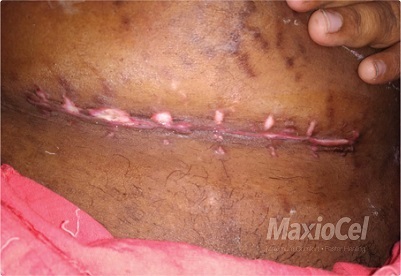C-SECTION INFECTED SUTURE LINE
MaxioCel - 100% Chitosan Wound Dressing on C-Seciton Infected Suture Line
Center
LHMC Hospital, New Delhi-India: Supervising Doctors-Dr.Kanika, Dr.Pratibha
Patient details: 28 years , Female
Diabetes: No
Nicotine Consumption: No
Wound Perpetuation: 1 Week
Nutritional Status: Well Nourished
Co-morbidities: None
Previous Medication: None
Wound History: One-week-old infected C-Section in a moderately obese woman. No previous treatment was done other than dressing with Povidone-Iodine and Gauze.
Tissue type

Initial Wound Bed Evaluation
| Infection (Local Factors) | Yes | No |
| Exudate | ✓ | |
| Erythema | ✓ | |
| Malodorous | ✓ | |
| Pain | ✓ | |
| Oedema | ✓ |
| Exudate | Dry | Low | Medium | High |
| Levels | ✓ |
| Exudate | Watery | Cloudy | Thick | Purulent | Red |
| Type | ✓ |

DAY 1

DAY 5

DAY 7
Wound Management Goals
| Parameters | Yes | No |
| Debridement | ✓ | |
| Infection Prevention | ✓ | |
| Exudate Management | ✓ | |
| Optimum Moisture Maintenance | ✓ | |
| Protect granulation tissue / Epithelializing tissue | ✓ |
End Report
| No of MaxioCel dressings done | 3 |
| Frequency of MaxioCel dressings | Alternate days |
| MaxioCel Variant used | MX1010 |
| Final day wound condition | Quick healing was seen as gaping site was restored as desloughing and granulation had taken place.Wound was not bleedinganymore on cleaning.Pain score was reduced as well |
Result
| Patient Outcome with Maxiocel | Ease of Application/Removal | Antimicrobial barrier | Wound adherence | Conformability | Wound scar improvement | Pain management |
| Excellent | ✓ | ✓ | ✓ | ✓ | ✓ | ✓ |
| Good | ||||||
| Fair | ||||||
| Poor |
Discussion
- Alow-transverse incision is used in 95 percent of C-sections today. That’s because it’s done across the lowest part of the uterus, which is thinner-resulting in less bleeding. The incision on the uterus is mostly closed with dissolvable stitches.
- Women whose C-section incisions are closed with stitches may be significantly less likely to develop wound complications than those whose incisions are closed with staples.
- The signs of infection in a C-Section are these-redness, swelling, fever higher than 100.4 F, oozing or drainage from the incision site, foul smell from the area, the wound becomes hard with increasing pain around the wound and in the worst case if the incision splits open.
- Factors to prevent infection after surgery include keeping the wound clean, covering the wound with a suitable dressing for as long as the doctor advises and adhering to any prescribed courses of medication.
- In the said case, C-Section wound treatment was done using MaxioCel for a period of 7 days, 3 dressings were done on
alternative days. The suture line was beginning to the gap and was mildly bleeding during the initial dressing. - Within 3 sets of dressings done over a period of 7 days by cleaning with Normal Saline and dressing with MaxioCel, significant wound healing and quick recovery were seen. Patient comfort was evident as there was a reduction in pain too.
- Overall, MaxioCel was found to be an excellent wound dressing in patients suffering from infected suture lines.
 A collaborative study with Harvard Medical School
A collaborative study with Harvard Medical School